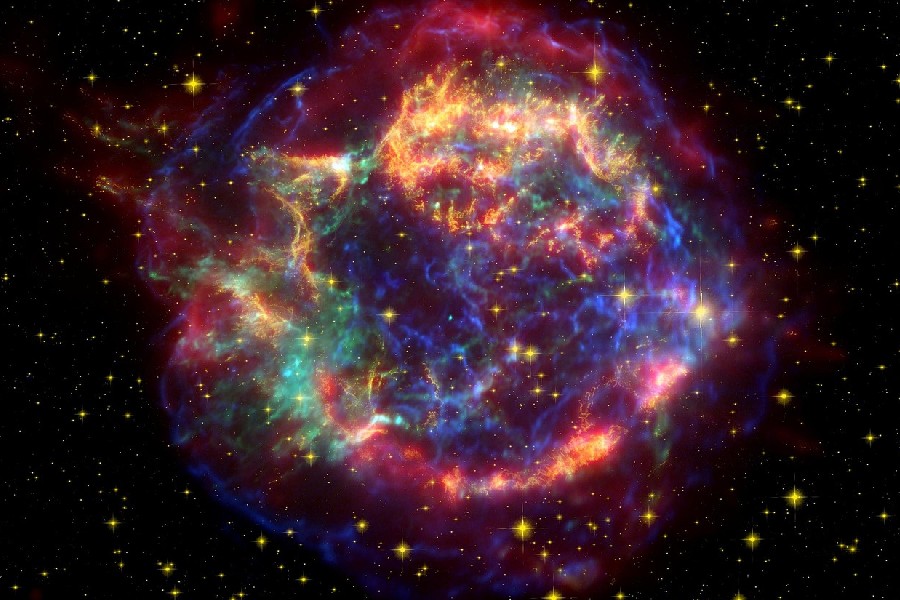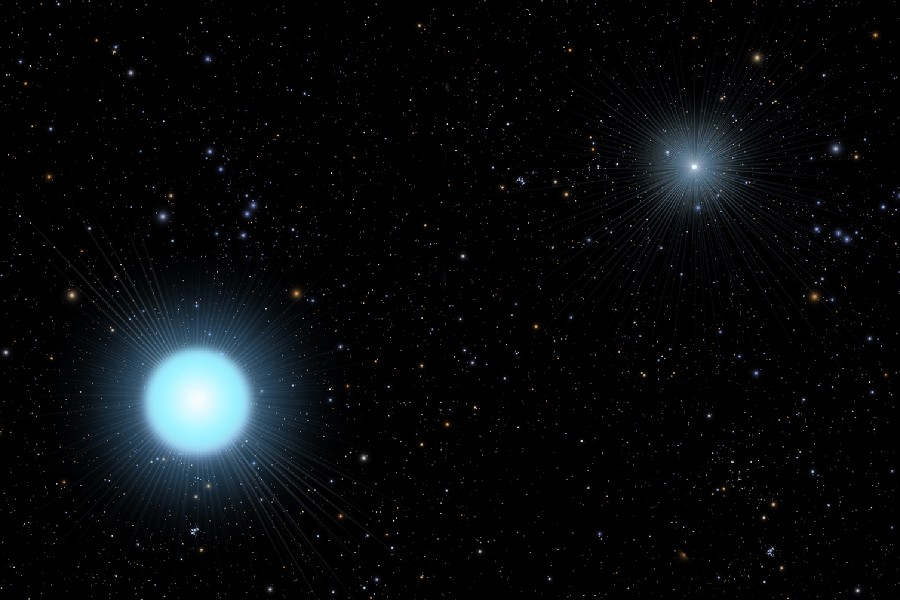As incredibly powerful and awe-inspiring events that occur often, supernovas explode in a brilliant display of light and energy, releasing vast amounts of matter into space. These cosmic explosions are responsible for creating elements essential for life and shaping the universe as we know it. What is a supernova exactly?
Read on to understand the science behind supernovae, those violent explosions of massive stars written across the cosmos. As we explore different supernova types and their lasting impacts, we’ll discover how scientists detect and analyze these phenomena through cosmic lenses.
We’ll also find out how heavy metals dispersed by supernovae enabled life on Earth by contributing to the formation of star systems with livable planets later in cosmic history. Let’s see more precisely how does a supernova happen with these catastrophic stellar explosions seen across intergalactic distances!

What Is a Supernova?
What is a supernova? A supernova is a powerful stellar explosion marking the end of a star’s life cycle. It releases an immense amount of energy, outshining entire galaxies temporarily. There are two main types – Type I, ignited by a white dwarf, and Type II, resulting from the collapse of a massive star’s core.
Supernovae contribute to the creation and dispersal of heavy elements, influencing the cosmic cycle of matter and impacting the formation of new stars and planetary systems.
The Final Stage – Core Collapse Supernova
Stellar culmination
So, how is a supernova formed? A core collapse supernova unfolds with crushing finality for the most massive stars exceeding 10 solar masses once their fuel expires after millions of years fusing heavy elements.
With no further reactions possible, the inert iron core suddenly implodes under its own immense gravity, compacting inner layers so extremely that protons and electrons merge into neutrons.
This collapse rebounds dramatically off the ultra-compressed core, producing a titanic shock wave erupting the star’s outer layers outward at up to 10% light speed velocity that briefly fuels luminosity rivaling an entire galaxy.
The shattered remnants may form an exotic neutron star or total gravitational annihilation into a black hole based on the original star’s size.
Cosmic significance
These violent conclusions mark monumental stages in stellar lifetimes while dispersing heavy elements like oxygen, iron, and gold forged through fusion back into the interstellar medium. This expands chemistry to enable next generations of star and planet formation cycles.
Core collapse supernovae also generate and fling out high energy particles that may spark nebula formation and new stars condensing from radical shape disruption propagated across light years. So, in destruction lies the seeding of rebirth.
White Dwarf Star Theory
White dwarf fundamentals
A white dwarf constitutes the dense remnant core of a low to medium-mass star after it expires and sheds its outer atmospheric layers. About the size of Earth yet containing up to 1.4 solar masses, white dwarfs consist of degenerate carbon and oxygen.
This material resists further gravitational collapse through electron quantum physics pressure. Cooling gradually over billions of years without internal fusion, most white dwarfs fade exceptionally slowly by astronomical standards.
Link to supernova events
Yet some white dwarfs demonstrate extraordinary potential energy if gaining enough material from a nearby stellar companion through accretion.
By exceeding 1.4 solar masses, dubbed the Chandrasekhar limit, runaway nuclear reactions ignite as gravity rapidly compresses the star’s core, utterly obliterating it in a brilliant detonation outshining the galaxy temporarily.
This white dwarf going supernova illustrates instability when sufficient matter piles up beyond strictly defined support limits regarding electron degeneracy’s capacity resisting gravitational constriction.

White Dwarfs in Binary Star Systems
Binary star dynamics
Many stars exist in gravitationally bound binary pairs orbiting a common center of mass. In some close binary systems, expanding red giants will transfer hydrogen-rich atmospheric material during later evolutionary stages onto an orbiting white dwarf companion star.
This accretion process gradually builds up layer upon layer of transferred gases containing hydrogen and helium.
Mass transfer process
This mass transfer process can continue for millions of years in certain binary star systems. The white dwarf will accumulate and incorporate more helium and hydrogen from its red giant companion over long time periods through steady or episodic accretion until hitting critical physical constraints.
Contribution to supernovae
If sufficient accretion occurs in this stellar dance, the white dwarf’s mass may ultimately exceed 1.4 solar masses – the Chandrasekhar limit where electron degeneracy pressure proves incapable of counteracting gravity’s mighty crush.
Reaching this critical threshold, sparking runaway thermonuclear fusion through the star’s body results in titanic detonation, blasting the white dwarf completely apart in a brilliant Type 1a supernova visible across cosmic distances.
So, while most white dwarfs slowly cool for eons, exceptions embedded within binary star waltzes carry profound explosive potential energy if reaching unstable tipping points.
Thermonuclear Explosion as Cause
Exploring thermonuclear explosions
In stars, nuclear fusion generates energy by fusing lighter atomic nuclei into heavier elements. Fusion propagates smoothly inside most stars for billions of years. Yet uncontrolled, rapidly escalating fusion known as a thermonuclear explosion can detonate a white dwarf star.
This occurs in certain binary systems after the white dwarf accumulates a critical mass through accretion from its neighboring stellar companion. This runaway process involves escalating nuclear reactions bursting through the star exponentially faster in a flash.
Like an atomic chain reaction version of lightning traveling through the body of the star, it triggers utter obliteration when fusion initiates but cannot halt structurally changing everything at quantum scales in seconds.
Mechanisms involved
Within the white dwarf, incremental mass addition compresses the star while also elevating core temperature. Upon reaching Chandrasekhar limit mass, uncontrolled ignition spreads as higher elements fuse faster than escaping energy can check the propagation velocity.
Their blast tears white dwarfs apart at thousands of miles per second, forging and flinging atomic shrapnel that will lock some heavy metals into surrounding stellar environments.
Imagine a cosmic time bomb slowly ticking away as binary star systems evolve. In these systems, seemingly ordinary fading stellar remnants become containers of immense cataclysmic power.
Neutron Star Theory
Neutron stars form from the supernova collapse of 10-29 solar mass stars. Gravity crushes the protons and electrons into neutrons, creating a 12-15 mile wide core with 1.5-2 solar masses, spinning rapidly with powerful magnetic fields. Their birth is tied to stellar life cycles.
Neutron stars demonstrate extreme physics unreplicable on Earth. A teaspoon of a neutron star has 480 billion tons of density. Their immense magnetism and rapid rotation beam radiation as a detectable pulsar. They provide cosmic labs for nuclear interactions, fluid dynamics, quantum effects, and relativity.
Radio pulses reveal distant pulsars. Accreting neutron stars emit observable X-rays. Future gravitational wave and X-ray observatories will further detect neutron star collisions, expanding knowledge of their physics.
Shock Wave Impact on Nearby Objects
The explosive kinetic energy of a supernova drives powerful blast waves for hundreds of light years, propagating at up to 10% the speed of light. These shock fronts compress, heat and accelerate any surrounding material, such as gas clouds, dust structures, and planetary nebulae remnants from prior stellar lives.
Cosmic sculpting
Such extreme shocks spark new rounds of star birth or destroy planet-forming cloud cores. The very structure of galaxies can be reshaped over cosmic timescales by repeating supernova explosions.
These explosions drive gas outwards and shock the gas into new densities and forms. Even across immense gulfs of space, supernovae display their transformative power over stellar nurseries and galaxies.
Conclusion
In conclusion, we hope this article has helped expand your understanding of the pivotal cosmic events known as supernovae. By exploring what is a supernova and how these violent explosions end some stars’ lives in brilliant fashion, you now grasp part of their transformative power across cosmic scales.
Additionally, in covering their role in seeding the universe with life-enabling elements and resulting in exotic leftover objects like neutron stars, you understand more of supernovae’s profound impact.
Supernovae show that even destruction can create, with new stars emerging from the remnants of old ones. As cosmic engines, these explosive phenomena propel the story of our universe forward.
From driving stellar life cycles to revelations about physics, supernovae illuminate the interconnected nature of our cosmos. We hope you feel enlightened on what is a supernova and its profound celestial impact.
